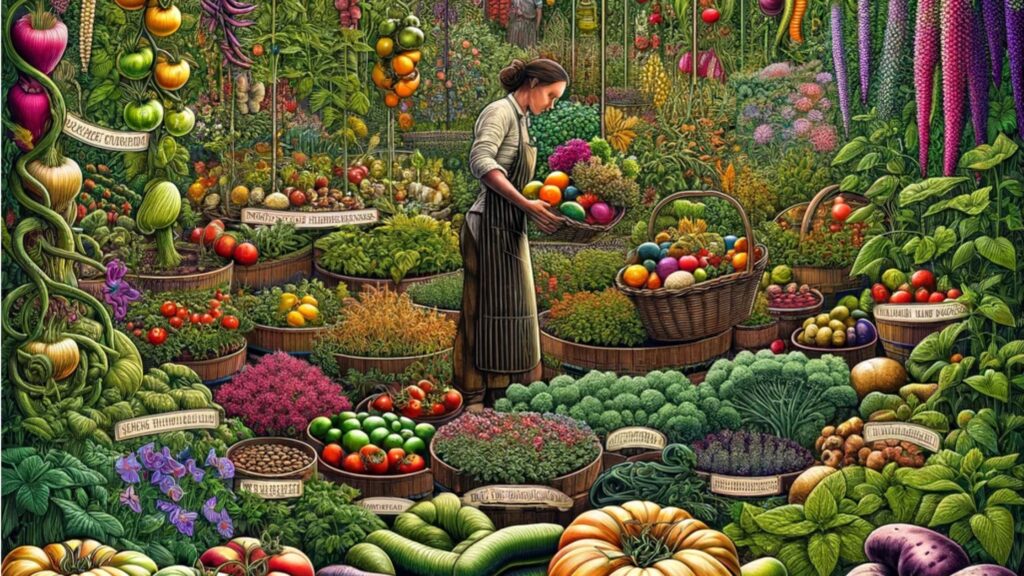
I found myself standing in the garden staring at 2 over grown oregano plants wondering what can I do with it all. There is a chill in the air and it feels like it is time to prepare for winter. If you are like me and enjoy having the garden put away and available for winter meals, the following recipes might aid you in your self sufficiency journey.
I look at the history of oregano and then get into some recipes and ways to preserve it.
Origins and Early History
Oregano, known scientifically as Origanum vulgare, is native to the Mediterranean region. The ancient Greeks and Romans were among the first to use oregano in their cooking, believing it to be a symbol of joy and happiness. The name “oregano” comes from the Greek words “oros,” meaning mountain, and “ganos,” meaning joy, which reflects its widespread growth on mountain slopes and its esteemed status in ancient cultures.
Culinary Uses in Antiquity
In ancient Greece, oregano was used not only for its flavour but also for its medicinal properties. It was often added to meats, fish, and wines. The Romans, who were known for their love of strong flavours, also adopted oregano and used it in various dishes, particularly in sauces and stews. Oregano became a key ingredient in Roman cuisine, especially in recipes involving game meat and lamb.
Middle Ages and Beyond
During the Middle Ages, oregano spread throughout Europe, where it was used to season meats, soups, and stews. It was also used in bread and vegetable dishes, adding a robust flavour to otherwise simple meals. In medieval times, oregano was sometimes used as a preservative due to its antimicrobial properties.
As European explorers set sail for the New World, oregano made its way to the Americas. It was initially used more for its medicinal qualities but soon found a place in the culinary traditions of Mexico and the southwestern United States. In these regions, oregano was often used in combination with other local herbs to flavour beans, stews, and meats.
Modern Culinary Uses
Today, oregano is most famously associated with Italian and Mediterranean cuisines. It is a key ingredient in pizza sauce, marinara, and various pasta dishes. In Greece, oregano is still commonly used in traditional dishes such as souvlaki (grilled meat skewers) and horiatiki (Greek salad).
In Mexican cuisine, oregano is used to season everything from salsas and tacos to soups and stews. Mexican oregano, a related but distinct variety, has a slightly different flavour profile, with citrus and licorice notes, and is often preferred in these dishes.
Historical Recipes Featuring Oregano
- Ancient Roman Lamb Stew: This hearty dish featured lamb, garlic, onions, and a generous amount of oregano, slow-cooked in wine to create a rich, flavorful stew.
- Medieval Herb Bread: Oregano was used alongside other herbs like thyme and rosemary in bread recipes, giving the loaves a fragrant and flavorful crust.
- Traditional Greek Souvlaki: Oregano is essential in the marinade for souvlaki, which includes olive oil, lemon juice, garlic, and oregano, giving the meat its characteristic flavour.
- Mexican Pozole: A traditional hominy-based stew, often made with pork or chicken, seasoned with Mexican oregano, garlic, and chili peppers, creating a vibrant and comforting dish.
Oregano’s versatility and robust flavour have made it a beloved herb in kitchens around the world. Whether in a simple salad dressing or a complex stew, oregano continues to be a culinary favorite, deeply rooted in history.
Preserving Oregano
Putting oregano away allows you to enjoy its vibrant flavour year-round. Here are several methods to preserve oregano:
Drying
Drying is one of the most common and effective ways to preserve oregano.
- Air Drying: Gather a bunch of oregano sprigs and tie them together at the stems. Hang the bunch upside down in a well-ventilated, dry, and dark place. After about two weeks, the leaves should be dry and crumbly. Strip the leaves from the stems and store them in an airtight container.
- Oven Drying: Spread oregano sprigs or leaves on a baking sheet lined with parchment paper. Set your oven to its lowest setting (around 170°F or 75°C) and leave the door slightly open. Dry the oregano for 1-2 hours, checking frequently to avoid burning. Once dry, store the leaves in an airtight container.
- Dehydrator: If you have a dehydrator, place the oregano leaves on the trays and set the dehydrator to 95°F-115°F (35°C-46°C). Dry for 1-4 hours, depending on the humidity level, until the leaves crumble easily.
Freezing
Freezing oregano helps preserve its fresh flavour, though the texture will change.
- Whole Leaves: Place washed and dried oregano sprigs or leaves in a single layer on a baking sheet. Freeze them until solid, then transfer to a freezer-safe bag or container. This method allows you to grab a few leaves as needed.
- Chopped Oregano: Chop the oregano leaves and place them in an ice cube tray. Cover the chopped oregano with water or olive oil and freeze. Once frozen, pop the cubes out and store them in a freezer-safe bag. These cubes can be added directly to soups, stews, or sauces.
Oregano-Infused Oil
Infusing oregano in oil is another way to preserve its flavour, though it needs to be done with care to avoid spoilage.
- Cold Infusion: Place fresh oregano sprigs in a clean, dry jar, and cover them with olive oil. Seal the jar and store it in the refrigerator. Use within a week to avoid the risk of botulism.
- Hot Infusion: Heat olive oil in a saucepan until warm, then add fresh oregano sprigs. Allow the mixture to cool, then strain out the herbs and pour the oil into a clean bottle. Store in the refrigerator and use within a week.
Herb Butter
Oregano herb butter is a delicious way to preserve the flavour and is perfect for adding to dishes.
- Making Herb Butter: Soften a stick of butter and mix in finely chopped oregano. Shape the butter into a log and wrap it in parchment paper or plastic wrap. Freeze the log and slice off pieces as needed for cooking.
Oregano Vinegar
Oregano-infused vinegar adds a unique flavour to dressings and marinades.
- Infusing Vinegar: Fill a jar with fresh oregano sprigs, then cover with vinegar (white wine vinegar works well). Seal the jar and let it sit in a cool, dark place for 2-4 weeks. Strain out the oregano and transfer the vinegar to a clean bottle.
Salt or Sugar Preservation
Preserving oregano in salt or sugar is a less common method but can create a flavourful seasoning.
- Herb Salt: Layer fresh oregano leaves with coarse salt in a jar. After a few weeks, the salt will absorb the flavour of the oregano. Use the flavoured salt in cooking.
- Herb Sugar: Though more unusual, you can also create herb-infused sugar by layering oregano with sugar. This is more suitable for certain culinary applications like baking or cocktail making.
Oregano Salt Recipe
Ingredients:
- 1 cup fresh oregano leaves (or 1/3 cup dried oregano)
- 1/2 cup coarse sea salt (you can adjust the amount based on your taste preference)
Instructions:
- Prepare the Oregano:
- If you’re using fresh oregano, wash and thoroughly dry the leaves. It’s crucial that the oregano is completely dry to prevent the mixture from spoiling. You can use a salad spinner or pat the leaves dry with a clean towel.
- Chop the Oregano:
- Finely chop the fresh oregano leaves. If you’re using dried oregano, you can skip this step.
- Combine with Salt:
- In a mortar and pestle, spice grinder, or food processor, combine the chopped oregano (or dried oregano) with the coarse sea salt. Grind the mixture until the oregano is well integrated into the salt, and the texture is consistent.
- Dry the Mixture:
- Spread the oregano salt mixture on a baking sheet lined with parchment paper. If you used fresh oregano, let the mixture air dry in a well-ventilated area for 2-3 days, stirring occasionally to ensure even drying. Alternatively, you can dry it in the oven at the lowest setting (around 170°F or 75°C) for 1-2 hours, stirring occasionally. If you used dried oregano, this step is optional, as the mixture will already be dry.
- Store the Oregano Salt:
- Once the mixture is completely dry, transfer it to an airtight container or glass jar. Store it in a cool, dark place. The oregano salt will keep its flavor for several months.
Uses:
- Seasoning: Use oregano salt to season meats, vegetables, pasta, and salads. It’s particularly good as a finishing salt for roasted dishes.
- Marinades: Mix oregano salt with olive oil and lemon juice to create a simple and flavorful marinade for grilled meats or vegetables.
- Bread Topping: Sprinkle oregano salt over bread dough before baking to add an herby twist to your loaves or focaccia.
This oregano salt recipe is a versatile way to preserve and enhance the flavour of oregano, making it a handy addition to your kitchen pantry.
Each preservation method offers a unique way to capture oregano’s flavour, allowing you to choose based on your culinary needs and storage preferences.
Using Oregano in Herbal Blends or Yummy Recipes.
Oregano is a versatile herb that shines in various herbal blends and teas, offering robust flavour and health benefits. Here are some recipes that use a generous amount of oregano:
Mediterranean Herb Blend
This classic herb blend is perfect for seasoning meats, vegetables, and grains.
Ingredients:
- 3 tablespoons dried oregano
- 2 tablespoons dried thyme
- 2 tablespoons dried rosemary
- 1 tablespoon dried basil
- 1 tablespoon dried marjoram
- 1 tablespoon dried parsley
- 1 tablespoon dried mint
- 1 tablespoon garlic powder (optional)
- 1 teaspoon dried sage
- 1 teaspoon dried dill
Instructions:
- Combine all the dried herbs in a mixing bowl.
- Mix well until all the herbs are evenly distributed.
- Store the blend in an airtight container in a cool, dark place. Uses: This herb blend is excellent for marinades, rubs, and adding to sauces or soups. It’s especially good on roasted vegetables and grilled meats.
Italian Seasoning Mix
An essential blend for Italian cuisine, featuring oregano as a key ingredient.
Ingredients:
- 3 tablespoons dried oregano
- 2 tablespoons dried basil
- 1 tablespoon dried thyme
- 1 tablespoon dried rosemary
- 1 tablespoon dried marjoram
- 1 teaspoon dried sage
- 1 teaspoon dried garlic powder (optional)
- 1 teaspoon dried red pepper flakes (optional for a bit of heat)
Instructions:
- Mix all the ingredients in a bowl until well combined.
- Store the blend in an airtight jar or container. Uses: This seasoning mix is perfect for pasta sauces, pizzas, and roasted dishes. It can also be used to season soups, stews, and bread dough.
Greek Oregano Rub
A flavourful rub that showcases oregano, ideal for grilled meats and vegetables.
Ingredients:
- 4 tablespoons dried oregano
- 2 tablespoons dried thyme
- 2 tablespoons dried rosemary
- 1 tablespoon dried mint
- 1 tablespoon dried parsley
- 2 teaspoons dried garlic powder
- 1 teaspoon dried lemon zest
- 1 teaspoon ground black pepper
- 1 teaspoon sea salt
Instructions:
- Combine all the herbs and spices in a bowl.
- Mix thoroughly to ensure even distribution.
- Store in an airtight container. Uses: Rub this blend onto chicken, lamb, or vegetables before grilling or roasting. It also works well sprinkled over Greek salads or potatoes.
Oregano Herbal Tea
Oregano tea is a soothing and aromatic beverage, often used for its health benefits, including aiding digestion and providing antioxidants.
Ingredients:
- 2 tablespoons fresh oregano leaves (or 1 tablespoon dried oregano)
- 2 cups boiling water
- Honey or lemon (optional, to taste)
Instructions:
- Place the fresh or dried oregano leaves in a teapot or infuser.
- Pour the boiling water over the oregano.
- Let the tea steep for 5-10 minutes, depending on your desired strength.
- Strain the leaves and pour the tea into a cup.
- Add honey or lemon if desired. Uses: Drink oregano tea to soothe a sore throat, aid digestion, or simply enjoy its warm, herbal flavor. It can also be cooled and used as a base for a refreshing iced tea.
For more recipes on how to preserve oregano in remedies, you can visit Garden Faerie Botanicals Blog Post called, “From Kitchen to Medicine Cabinet: Oregano’s Amazing Healing Recipes“.
Oregano and Basil Pesto
A twist on the classic pesto recipe, using oregano for a more robust flavor.
Ingredients:
- 2 cups fresh basil leaves
- 1/2 cup fresh oregano leaves
- 1/4 cup pine nuts (or walnuts)
- 2 cloves garlic, minced
- 1/2 cup olive oil
- 1/4 cup nutritional yeast or vegan Parmesan
- Salt and pepper to taste
Instructions:
- Combine the basil, oregano, pine nuts, and garlic in a food processor.
- Pulse until the ingredients are finely chopped.
- With the processor running, slowly drizzle in the olive oil until the mixture becomes a smooth paste.
- Add the nutritional yeast, salt, and pepper, and pulse a few more times to combine.
- Store the pesto in an airtight container in the refrigerator. Uses: Use this pesto on pasta, spread it on sandwiches, or as a dip for vegetables. It’s also delicious as a sauce for grilled tofu or as a topping for roasted vegetables.
Oregano As A Herbal Delight In Breads
Oregano can be a star ingredient in various bread recipes, including quick breads, flatbreads, and even focaccia. Here are some recipes where oregano shines as the main herb:
Oregano Focaccia
Focaccia is a classic Italian flatbread that’s easy to make and can be flavoured with a variety of herbs, with oregano being a popular choice.
Ingredients:
- 4 cups all-purpose flour
- 2 teaspoons salt
- 1 tablespoon sugar
- 1 tablespoon active dry yeast
- 1 1/3 cups warm water
- 1/4 cup olive oil, plus more for drizzling
- 2 tablespoons fresh oregano leaves (or 1 tablespoon dried oregano)
- Coarse sea salt, for sprinkling
Instructions:
- Prepare the Dough:
- In a small bowl, dissolve the sugar and yeast in warm water. Let it sit for about 5 minutes until foamy.
- In a large bowl, mix the flour and salt. Make a well in the center and add the yeast mixture and olive oil.
- Stir until a dough forms, then knead on a lightly floured surface for about 10 minutes until smooth and elastic.
- First Rise:
- Place the dough in a lightly oiled bowl, cover it with a damp cloth, and let it rise in a warm place for about 1 hour, or until doubled in size.
- Shape the Focaccia:
- Punch down the dough and transfer it to a greased baking sheet. Press it out with your fingers to form a rectangular shape, about 1/2 inch thick.
- Cover the dough loosely with plastic wrap and let it rise for another 20-30 minutes.
- Add Toppings:
- Preheat your oven to 400°F (200°C).
- Use your fingers to dimple the surface of the dough. Drizzle generously with olive oil, then sprinkle the oregano leaves over the top. Add coarse sea salt to taste.
- Bake:
- Bake for 20-25 minutes, or until the focaccia is golden brown and cooked through.
- Remove from the oven and let it cool slightly before slicing and serving.
Oregano and Cheese Quick Bread
This savoury quick bread is flavoured with oregano and cheese, making it a perfect snack or side dish.
Ingredients:
- 2 cups all-purpose flour
- 1 tablespoon baking powder
- 1 teaspoon salt
- 1 tablespoon dried oregano (or 2 tablespoons fresh oregano, chopped)
- 1 cup grated cheese (cheddar, Parmesan, or a mix)
- 1 cup milk
- 1/4 cup olive oil or melted butter
- 2 large eggs
Instructions:
- Preheat the Oven:
- Preheat your oven to 350°F (175°C). Grease a 9×5 inch loaf pan.
- Mix Dry Ingredients:
- In a large bowl, whisk together the flour, baking powder, salt, and dried oregano. Stir in the grated cheese.
- Mix Wet Ingredients:
- In a separate bowl, whisk together the milk, olive oil (or melted butter), and eggs until well combined.
- Combine:
- Pour the wet ingredients into the dry ingredients and stir until just combined. Be careful not to overmix.
- Bake:
- Pour the batter into the prepared loaf pan and smooth the top. Bake for 45-55 minutes, or until a toothpick inserted into the center comes out clean.
- Allow the bread to cool in the pan for 10 minutes before transferring it to a wire rack to cool completely.
Vegan Oregano and Cheese Quick Bread
Here’s a vegan version of the oregano and cheese quick bread recipe, using plant-based ingredients:
Ingredients:
- 2 cups all-purpose flour
- 1 tablespoon baking powder
- 1 teaspoon salt
- 1 tablespoon dried oregano (or 2 tablespoons fresh oregano, chopped)
- 1 cup shredded vegan cheese (cheddar or mozzarella-style)
- 1 cup unsweetened plant-based milk (such as almond, soy, or oat milk)
- 1/4 cup olive oil or melted vegan butter
- 2 tablespoons ground flaxseed + 6 tablespoons water (to replace eggs)
Instructions:
- Preheat the Oven:
- Preheat your oven to 350°F (175°C). Grease a 9×5 inch loaf pan or line it with parchment paper.
- Prepare the Flax Eggs:
- In a small bowl, combine the ground flaxseed and water. Stir well and let it sit for about 5 minutes until it thickens and becomes gel-like.
- Mix Dry Ingredients:
- In a large bowl, whisk together the flour, baking powder, salt, and dried oregano. Stir in the shredded vegan cheese.
- Mix Wet Ingredients:
- In a separate bowl, whisk together the plant-based milk, olive oil (or melted vegan butter), and flaxseed mixture until well combined.
- Combine:
- Pour the wet ingredients into the dry ingredients and stir until just combined. Be careful not to overmix.
- Bake:
- Pour the batter into the prepared loaf pan and smooth the top. Bake for 45-55 minutes, or until a toothpick inserted into the center comes out clean.
- Allow the bread to cool in the pan for 10 minutes before transferring it to a wire rack to cool completely.
Uses:
This vegan oregano and cheese quick bread is delicious as a snack, side dish, or accompaniment to soups and salads. It’s also great toasted with a spread of vegan butter or avocado.
Greek Oregano Flatbread
This simple flatbread is infused with oregano, making it a great accompaniment to Mediterranean dishes.
Ingredients:
- 2 cups all-purpose flour
- 1 teaspoon salt
- 1 tablespoon dried oregano (or 2 tablespoons fresh oregano, finely chopped)
- 1 teaspoon sugar
- 1 teaspoon baking powder
- 1/4 cup olive oil
- 3/4 cup warm water
Instructions:
- Prepare the Dough:
- In a large bowl, whisk together the flour, salt, oregano, sugar, and baking powder.
- Add the olive oil and warm water. Stir until the dough begins to come together.
- Knead:
- Turn the dough out onto a floured surface and knead for about 5 minutes, until smooth and elastic.
- Rest the Dough:
- Place the dough in a lightly oiled bowl, cover it with a damp cloth, and let it rest for 30 minutes.
- Shape and Cook:
- Divide the dough into 4-6 equal pieces. Roll each piece into a thin round or oval shape.
- Heat a large skillet or griddle over medium heat. Cook each flatbread for 2-3 minutes on each side, until golden and cooked through.
These recipes highlight oregano’s ability to add depth and flavour to various types of bread, whether it’s a quick bread, focaccia, or flatbread.
As an easy to grow herb that comes back every year, does not need to be watered and has many uses, oregano is an herb that should be in every garden. I have 2 large plants and am looking forward to adding some different varieties next spring! If you are looking for heirloom oregano seeds, Garden Faerie Botanicals offers them.
I hope the herb blesses your taste buds and spice rack. The uses are so vast and I am just starting to discover just how versatile it is.
See you in the kitchen cooking with oregano!










